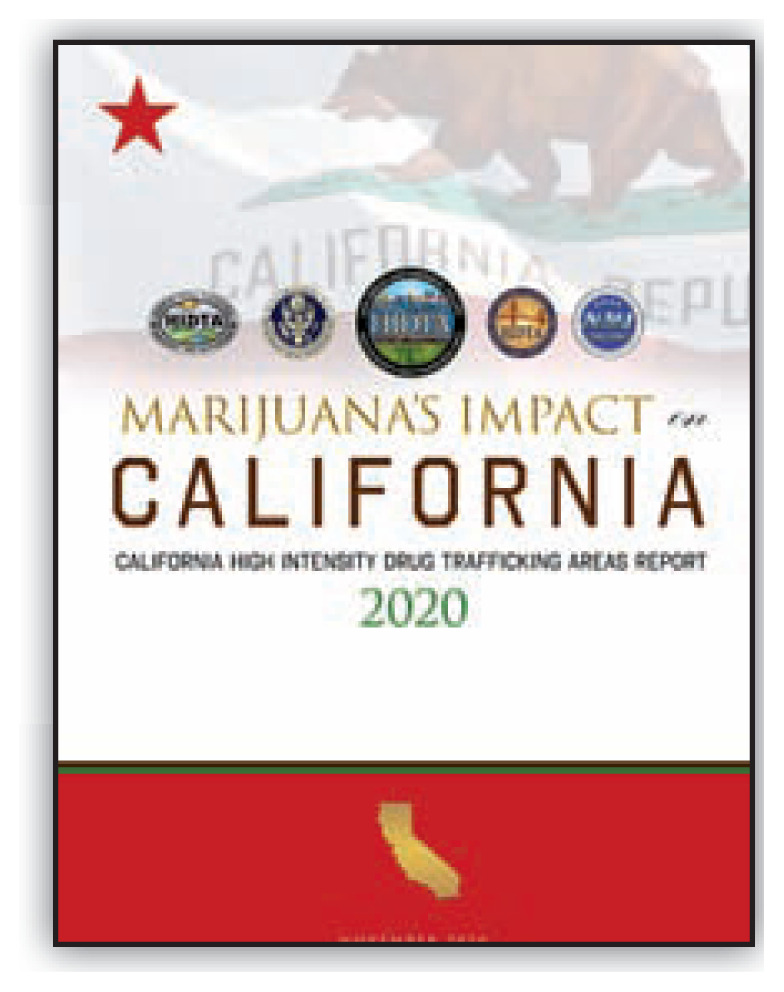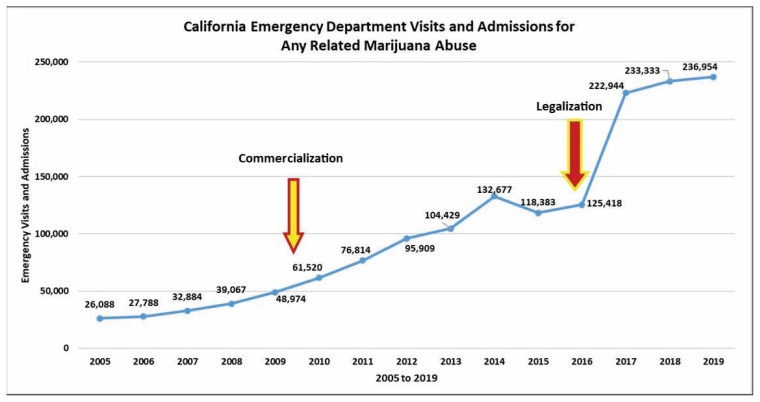Key Findings.
From 2016 (125,418) to 2019 (236,954), California emergency department visits and admissions for any related marijuana use has increased by 89%.
Cannabidiol-related (CBD) exposure calls in California increased from 2014 (3) to 2019 (1,526).
From 2005 (1,412) to 2019 (16,151) there was a 1044% increase in California emergency department visits and admissions for primary marijuana use, with a 56% increase from 2016 (10,361) to 2019 (16,151).
From 2005 (1,393) to 2019 (14,993) there was a 976% increase in California emergency department visits with marijuana-related occurrences.
E-Cigarette (vaping) and nicotine exposure calls in California from 2011 (269) to 2019 (5,335) has increased by 1883%.

Section One: Potency and Price of Marijuana
Nationally, the average potency of tetrahydrocannabinol (THC), the primary psychoactive found in marijuana, has risen in marijuana concentrates from 13.23% in 1995 to 60.95% in 2018.
Nationally, the average potency of tetrahydrocannabinol (THC), the primary psychoactive found in marijuana, has risen in traditional marijuana from 3.96% in 1995 to 16.16% in 2018.
The price of a pound (lb.) of marijuana in California can vary from $100 to $2,000 depending on THC potency level.
Section Two: Vaping
Nationally, lifetime (any) vaping use among middle and high school students has increased from 2017 to 2019: 8th grade increased from 1.6% to 3.9%, 10th grade increased from 4.3% to 12.6%, and 12th grade increased from 5.0% to 14.0%.
Nationally in 2019, the daily use of nicotine vaping is higher than the daily use of smoking tobacco across all grade levels: 1.9% vs. 0.8% in 8th grade, 6.9% vs. 1.3% in 10th grade and 11.7% vs. 2.4% 12th grade.
Nationally, the 30-day prevalence of marijuana (non-vaping), vaping marijuana and cigarette use increased across 8th, 10th, and 12th graders from 2017 to 2019, with the exception of cigarette use in 10th and 12th graders in 2019 which decreased from 5% to 3.4% and 9.7% to 5.7%.
From 2017 to 2018, national past month marijuana vaping use among college aged individuals more than doubled in those enrolled in college, while remaining relatively stable among those not in college.
Section Three: California Youth Marijuana Use Ages 12–17
California youth have consistently had a lower perception of risk of smoking marijuana once a month, compared to the national average (2010-2018).
California continues to have a higher rate of past month use of marijuana in individuals ages 12 and older (2011-2018).
Nationally in 2019, vaping (any substance) has surpassed alcohol and marijuana use for 8th and 10th graders.
Section Four: California Marijuana Use Ages 18–25
From 2017 to 2018, California’s marijuana use by 18- to 25-year-olds continued to surpass their use of cigarettes, 25.16% vs. 14.52%.
In California, 36.3% of adults aged 18 to 25 reported using cigarettes, e-cigarettes, or marijuana in 2018.
Section Five: California Marijuana Use Ages 26 and Older
From 2017 to 2018, California’s marijuana use for individuals 26 years and older continued to surpass the national average, 10.39% vs. 8.25%.
Section Six: California Arrests for Drug Sales, DUI, and Possession of Cannabis While Driving
In California, (state) arrests for the sale of marijuana has decreased from 2015 (8,368) to 2018 (1,857).
Section Seven: Public Health
From 2016 (125,418) to 2019 (236,954), California Emergency Department visits and admissions for any related marijuana abuse has increased by 89%.
From 2005 (1,412) to 2019 (16,151) there was a 1,044% increase in California emergency department visits and admissions for primary marijuana abuse, with a 56% increase from 2016 (10,361) to 2019 (16,151).
From 2005 (1,393) to 2019 (14,993) there was a 976% increase in California emergency department visits with marijuana as the primary reason for being seen.
Section Eight: Treatment
In California in 2019, 41% of marijuana treatment admissions were amongst those 12 to 17 years of age.
Section Nine: Diversion and Eradication
In 2019, 59% of illegal marijuana plant seizures occurred on private land (trespass grows/not by owner), which was a significant increase from 44% in 2018.
United States Customs and Border Protection, Air and Marine Operations (nationwide) marijuana seizures have increased by 176% from 59,396 lbs. in FY 2019 to 164,216 lbs. in 2020 (TD August).
Section Ten: THC Extraction Labs
There were 194 reported clandestine lab incidents in California in 2019. Out of the 194 reported labs, 72.6% were honey oil/THC extraction (141), followed by precursor chemicals 9.3% (18).
Section Eleven: Environmental Impacts of Marijuana Cultivation
Outdoor marijuana grow sites consume an estimated 29.4 million gallons of water per year.
Researchers estimate over 1.4 million pounds of fertilizers and toxicants are used annually at outdoor marijuana grows sites in California.
References
https://www.thenmi.org/wp-content/uploads/2020/12/CA-MJ-IMPACT-REPORT-2020-FINAL-.pdf (accessed 01/15/2021)
Footnotes
Marijuana’s impact on California November 2020 In 1996, California became the first state to legalize marijuana for medicinal purposes with the passage of Proposition 215. Now, in 2020, recreational marijuana use is fully legal within California for individuals 21 years of age and over. Below is the Executive Summary of the California High Intensity Drug Trafficking Area Report and the current and potential impacts of these policies.



